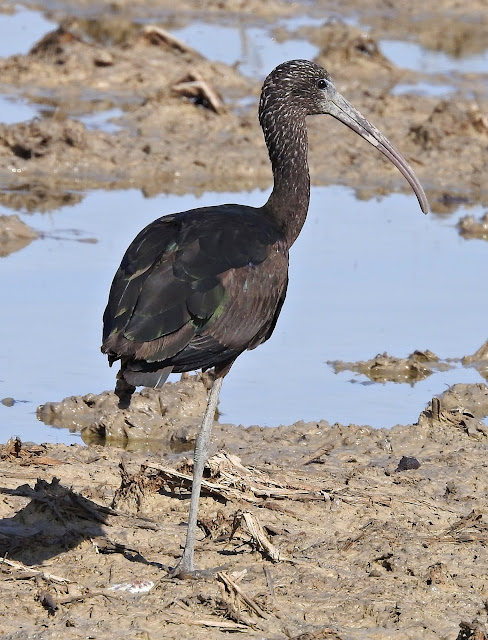The glossy ibis (Plegadis falcinellus ) is a water bird in the order Pelecaniformes and the ibis and spoonbill family Threskiornithidae. The scientific name derives from Ancient Greek plegados and Latin, falcis, both meaning "sickle" and referring to the distinctive shape of the bill.
The Glossy ibis is a medium-sized wading bird. They have long, slender, down-curved bill and magnificent plumage with shiny feathers. Breeding adults have reddish-brown bodies and shiny bottle-green wings. Non-breeders and juveniles have duller bodies. These birds have dark facial skin bordered above and below in blue-gray (non-breeding) to cobalt blue (breeding) and red-brown legs.
The Glossy ibis is the most widespread ibis species; it breeds in warm regions of Europe, Asia, Africa, Australia, and the Atlantic and Caribbean regions of the Americas. This species is migratory; most European birds winter in Africa, and in North America birds from north of the Carolinas winter farther south. Though generally suspected to be a migratory species in India, the Glossy ibis is a resident in western India. Birds from other populations may disperse widely outside the breeding season. Glossy ibises inhabit wetlands with tall dense stands of emergent vegetation such as reeds, papyrus or rushes, and low trees or bushes. They show a preference for marshes at the margins of lakes and rivers but can also be found at lagoons, flood-plains, wet meadows, swamps, reservoirs, sewage ponds, paddies, and irrigated farmland. These birds are less commonly found in coastal locations such as estuaries, deltas, salt marshes, and coastal lagoons.
Glossy ibises are diurnal birds. They are gregarious and nest in colonies. When not nesting, flocks of over 100 individuals may occur on migration, and during the winter or dry seasons, these birds usually forage in small flocks. Glossy ibises often roost communally at night in large flocks, with other species, occasionally in trees which can be some distance from wetland feeding areas. Glossy ibises hunt their prey by sight and touch. When foraging on land, they pick and glean insects or grain but when feeding along the shore, they use their long bills to probe into the substrate or mud. Glossy ibises are able to swim, however, they generally try to avoid deep water. Sounds made by these rather quiet birds include a variety of croaks and grunts; they also make a hoarse 'grrrr' when breeding.

